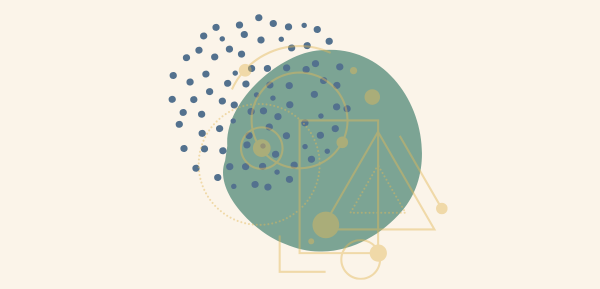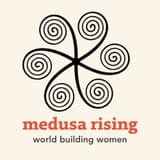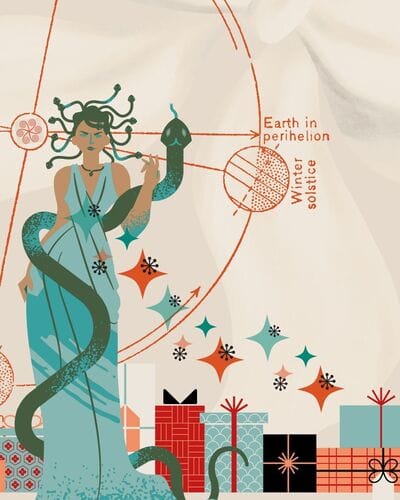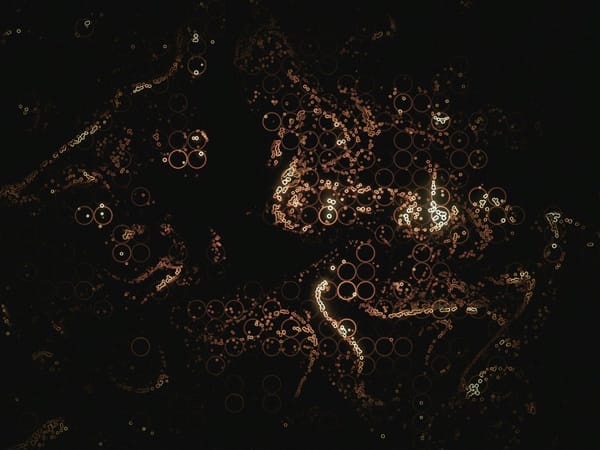Asymmetrical Re-Worlding, Part 2: The Dance of Relationship | by Therese Doherty
:D I did not choose this essay because I am often quoted in it. I chose it because it's a brilliant synthesis of complex ideas beautifully presented.

Subscribe between now and Halloween, and get six months of a $12 rate for $8, includes private event invites, first event just after Halloween, two more in winter.
OR:
(. ❛ ᴗ ❛.) Special request of a tip. (. ❛ ᴗ ❛.)
We do love to pay these writers, reporters, artists.
Therese here worked on this essay for most a year.
Real thinking needs time.

Part 2: The Dance of Relationship
In Part 1 I discussed the system of metaphysical dualism that fragments our experience of the world (leading to the feminine/masculine polarity which the postfeminists believe is a cosmic truth), and ended with the delicious paradox of the yin yang symbol, spinning as the two opposing (yet integrated) sides whirl and coexist harmoniously.
Rather than a fixed opposition, Esmée Streachailt writes that the difference of the two sides of a dualism (or binary) is more accurately described by Jacques Derrida’s term différance—‘the generative movement in the play of differences’:[1]
Différance and play make meaning by respecting differences, the boundaries between A and B (and C and D ...), and that way making their relation possible. Baldly put in radical feminist terms: if woman is only a mirror that reflects and magnifies Man, then there can be no love because there is no woman other than as a service to Man. In the metaphysics of différance, the presence and boundaries of both concepts or kinds of subjects is not only acknowledged but activated in creativity.[2]
There is flow—moving and changing Life—a dance. Meaning is not rigidly assigned; it is an ongoing process of creativity. Though physiological sexual differences are real and will always be salient, psychologically and metaphysically there is no hard boundary that defines women as this and men as that. Such ‘Rigidity, especially of ideas like men (A) are good and rational and women (~A) are evil and hysterical … can only be maintained by force’.[3]
Pleasingly, mature, self-actualised humans don’t pay much heed to gender in their relationships. Instead, such women and men ‘are free to move about in love and relationship and “roles” with spontaneity and as needs-must’:
These couples “made no really sharp differentiation between the roles and personalities of the two sexes.” Crucially, as [Betty] Friedan puts it [in The Feminine Mystique], “These people were all so certain of their maleness or femaleness that they did not mind taking on some of the cultural aspects of the opposite sex role”.[4]
We’re all gender-nonconforming, and capable of change throughout our lives. We constantly adapt to different contexts, which is what all living beings do. But the postfeminist rhetoric I am referring to is re-inscribing ‘traditional’ gender roles to women and men as if these things are hardwired, a natural product of evolution that cannot be challenged. Male dominance and female submission, we are told, are biological. This isn’t a new idea, reeking as it does of what Andrea Dworkin described as the separate-but-equal model of antifeminism:
The model originates in the effort to justify the subordination of women to men (and in the justification to perpetuate that subordination) by positing male and female natures so biologically different as to require social separation, socially antithetical paths, social life bifurcated by sex so that there are two cultures, one male, one female, coexisting in the same society … The woman was supposed to bear and raise the children; the man was supposed to impregnate her and support them. These were separate-but-equal duties.[5]
But the truth is that adherence to traditional notions of femininity does not make women more naturally ourselves, it makes us less so. ‘A woman in patriarchy is like a square watermelon’, says Erin, a contributing editor of Medusa Rising. ‘She is made to take the shape of “femininity”, a form which makes it easier for men to exploit her.’ To grow naturally, without the restrictive ‘shaping’ of gender, makes us more free to express our unique personalities and grow into our becoming.
Interestingly, in the postwar years, as society was changing drastically and the women’s liberation movement was in its infancy, Susan Griffin observed in the women of her own family,
A different way of being in the flesh, of standing, talking, moving was evident between one generation and the next … women became more natural in our bodies and less confined by mannerisms prescribed as feminine. And one might also say in that case that we became more intimate with our own nature. Which was also a greater intimacy with nature itself.[6]
As Griffin writes over and over in her work, we are not separate from nature, nor is the body divided from the mind. The term ‘bodymind’ is often used to eliminate the conceptual confusion of mind/body dualism. Streachailt says, ‘We might better speak of a “bodyself” to emphasize how we are our bodies in the same way that space and time are more accurately called “spacetime”’.[7] The Chinese character xin, usually translated as ‘heart-mind’, reveals that feeling-thinking, body-mind, are coextensive. And David Abram says, ‘It is difficult, if not impossible, to conceive of how a mindful brain could have arisen except as an attribute of a muscled and sensing organism—how a brain could evolve independent of a breathing body fending for itself in the biosphere’.[8]

I’ll admit that years back, in my attempt to journey beyond the Mountains of Dualism (see Part 1) I probably got lost in the Cavern of Reversal for a while. If the disembodied, rational patriarchal mind is bad, then embodiment and the non-rational is good, right? The devalued Feminine does need to be re-acknowledged. But the return to the body that some women are now advocating (conveniently ignoring all the work that feminists have already done exploring the many realities, both challenging and joyful, of female embodiment since the heyday of the second wave), doesn’t do the work of integration, of making ourselves whole, body and mind intertwined. That step would take us beyond our socialisation. Postfeminism doesn’t critically assess the consequences of female embodiment and its accompanying sexualities beyond the male gaze or male sexual assumptions, and all the complexities and dangers of rape culture. Nor does it interrogate what is actually wrong with the patriarchal mind. Thinking and intellectualising isn’t really the problem—it’s the way that we do so that matters, and the values that underlie our efforts. ‘As a woman thinking’, Adrienne Rich wrote,
I experience no … division in my own being between nature and culture, between my female body and my conscious thought. In bringing the light of critical thinking to bear on her subject, in the very act of becoming more conscious of her situation in the world, a woman may feel herself coming deeper than ever into touch with her unconscious and with her body.[9]
When body and mind are rejoined, a new embodied way of thinking comes into being. This is core to feminist practice.
I’m reminded of Renée Gerlich’s insight, derived from yogic philosophy, that intellect follows identification:
Buddhi, intellect, is the discriminatory faculty. It is our non-judgemental and impartial capacity to discern x from y, a from b, man from woman. If we are cutting a carrot on a chopping board, buddhi allows us to distinguish between the carrot, the board, the knife, and our fingers. It is key to our survival, because without this discernment, we hurt ourselves.
But, crucially,
Buddhi is trumped by ahamkara, identification … Sadhguru, founder of Isha yoga, explains: “In the yogic system we consider the ahamkara, or the identity that you take on, far more important than the nature of the intellect itself – because intellect is a slave of the identity that you have taken.”
The ideological position that assumes that gender and relational hierarchy is hardwired, biological, and ‘essential’ to female and male natures has warped the thinking of those who adhere to it. If you identify with regressive notions of femininity and masculinity, then you’ll find it difficult to think beyond straitjacketed expectations.
The postfeminists might counter that feminism is itself an ideology that poisons women’s minds. But ‘Feminist theory is distinct from fundamentalist ideologies precisely because it does not begin with a set of rigid, pre-constructed concepts,’ Gerlich insists, ‘but with women’s subjective experience and commitment to humanisation shared in consciousness raising’.[10] In coming together and communicating about their experiences, women discovered the realities of their commonalities alongside exploration of their many differences (of socioeconomic class, race and ethnicity, sexuality, disability, and diverse life experiences). Thus, feminism
is constantly shaped and re-shaped as women pose questions about our lives and notice the patterns our experiences form. These patterns combine to form analysis, and this analysis is dynamic, changing as the times change. But the simple premise of women’s humanity, from which women’s experience arises and is spoken, does not change – because it is a premise based on love and observation, not dogma.[11]
Feminism is not an identity. It is a counter-knowledge. It’s a liberation movement, a method of analysis, a way of thinking-feeling-being, a practice, an ongoing process of personal development. It centres women and girls because male power is maintained by erasing and marginalizing us, but is ultimately humane, wanting the best world for all.
Trapped in their identification with the patriarchal abstractions they have reified, postfeminists ineffectively think through the concept of equality-as-sameness. Instead of replacing it with the possibility of a genuine egalitarian system founded on the partnership of women and men, with all of our diverse human personalities and possibilities, they merely restore an inequality-of-difference, based on retrograde ideas that are almost impossible to believe that anyone would hold in the contemporary world. No différance here.
Therese Doherty lives with chronic illness and occasionally writes and makes art, but mostly just reads a lot. She can be found here: @offeringsfromthewellspring.
Esmée Streachailt, ‘Re: Framing Radical Feminism: Welcome to the Occupation’, THE RADICAL NOTION, Issue Three (Spring 2021), p. 119 – all issues are available to read online or download for free here: https://theradicalnotion.org/ ↩︎
Streachailt, ‘Re: Framing Radical Feminism: Welcome to the Occupation’, p. 122 ↩︎
Esmée Streachailt, ‘Re: Framing Radical Feminism: Welcome to the Occupation, Cont.’, THE RADICAL NOTION, Issue Four (Summer 2021), p. 109 ↩︎
Esmée Streachailt, ‘Re: Framing Radical Feminism: The Plot Twist’, THE RADICAL NOTION, Issue One (Autumn 2020), p. 121 ↩︎
Andrea Dworkin, Right-wing Women, Perigee Books: New York, 1983, pp. 202-3 – find all of Dworkin’s books here: https://radfem.org/dworkin/ ↩︎
Susan Griffin, The Eros of Everyday Life: Essays on Ecology, Gender and Society, Doubleday: New York, 1995, p. 24 ↩︎
Esmée Streachailt, ‘Re: Framing Radical Feminism: Luce Irigaray and Being Beyond Patriarchy’, THE RADICAL NOTION, Issue Nine (Spring/Summer 2023), p. 71 ↩︎
David Abram, Becoming Animal: An Earthly Cosmology, Vintage Books: New York, 2010, p. 104 ↩︎
Adrienne Rich, Of Woman Born: Motherhood as Experience and Institution, W. W. Norton & Company: New York, 1986, p. 95 – find this book in the Radical Feminist Library ↩︎
Renée Gerlich, Out of the Fog: On Politics, Feminism and Coming Alive, Spinifex Press: North Geelong, 2022, p. 137 ↩︎
Gerlich, p. 137 ↩︎




